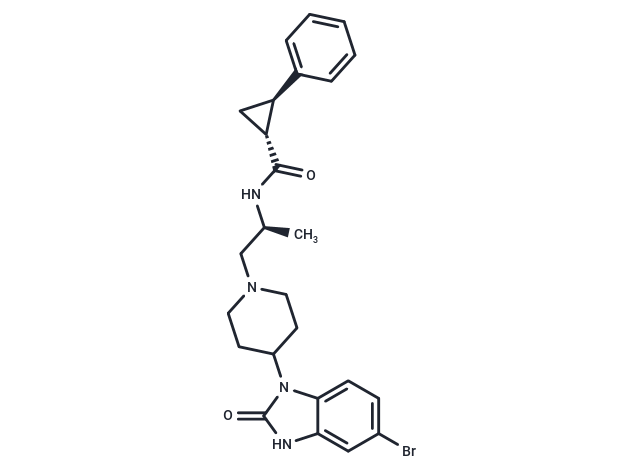Shopping Cart
- Remove All
 Your shopping cart is currently empty
Your shopping cart is currently empty

VU0359595 (ML-270) is a potent and selective pharmacological phospholipase D1 (PLD1) inhibitor with an IC50 of 3.7 nM. VU0359595 is >1700-fold selective for PLD1 over PLD2 (IC50 of 6.4 μM). VU0359595 can be used for the research of cancer, diabetes, neurodegenerative and inflammatory diseases.

| Pack Size | Price | Availability | Quantity |
|---|---|---|---|
| 1 mg | $81 | In Stock | |
| 5 mg | $197 | In Stock | |
| 10 mg | $313 | In Stock | |
| 25 mg | $538 | In Stock | |
| 50 mg | $787 | In Stock | |
| 100 mg | $1,070 | In Stock |
| Description | VU0359595 (ML-270) is a potent and selective pharmacological phospholipase D1 (PLD1) inhibitor with an IC50 of 3.7 nM. VU0359595 is >1700-fold selective for PLD1 over PLD2 (IC50 of 6.4 μM). VU0359595 can be used for the research of cancer, diabetes, neurodegenerative and inflammatory diseases. |
| In vitro | VU0359595, at concentrations ranging from 5 to 5000 nM, inhibits both the baseline and FCS/IGF-1 stimulated proliferation of astroglial cells. At doses of 5, 50, and 500 nM, with a 30-min exposure, it does not impact the basal phospholipase D (PLD) activity in astrocytes; however, it significantly reduces mitogen-stimulated PLD activity in a concentration-dependent manner[2]. Additionally, at a concentration of 0.15 μM administered 1 h before and during a 4 h high glucose treatment, VU0359595 notably decreases the high glucose-induced increase in [3H]-phosphatidylethanol (PEth) generation in retinal pigment epithelium (RPE) cells[3]. When applied at 5 μM one hour before lipopolysaccharide (LPS) treatment, it modulates autophagy in LPS-induced RPE cells undergoing a 24-h treatment with 10 μg/ml of LPS[4]. Furthermore, a 2 nM pre-exposure for 30 min effectively blocks the gliotoxin (50 ng/ml)-enhanced internalization of A. fumigatus in A549 cells[5]. |
| Alias | VU0359595-1, ML-270, CID-53361951 |
| Molecular Weight | 497.43 |
| Formula | C25H29BrN4O2 |
| Cas No. | 1246303-14-9 |
| Smiles | C[C@@H](CN1CCC(CC1)n1c2ccc(Br)cc2[nH]c1=O)NC(=O)[C@@H]1C[C@H]1c1ccccc1 |
| Relative Density. | 1.395 g/cm3 (Predicted) |
| Storage | Powder: -20°C for 3 years | In solvent: -80°C for 1 year | Shipping with blue ice. | ||||||||||||||||||||
| Solubility Information | DMSO: 4.98 mg/mL (10 mM), Sonication is recommended. | ||||||||||||||||||||
Solution Preparation Table | |||||||||||||||||||||
DMSO
| |||||||||||||||||||||

Copyright © 2015-2025 TargetMol Chemicals Inc. All Rights Reserved.